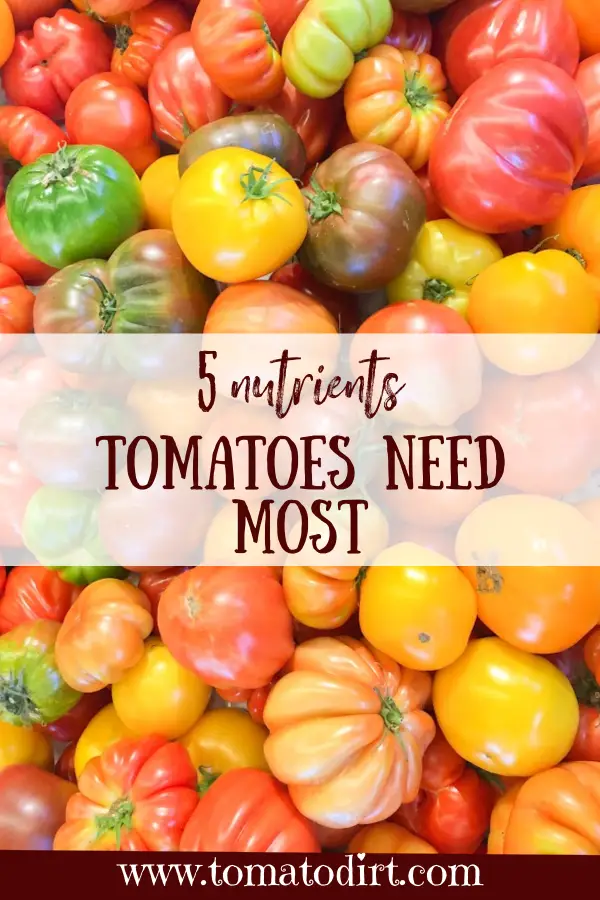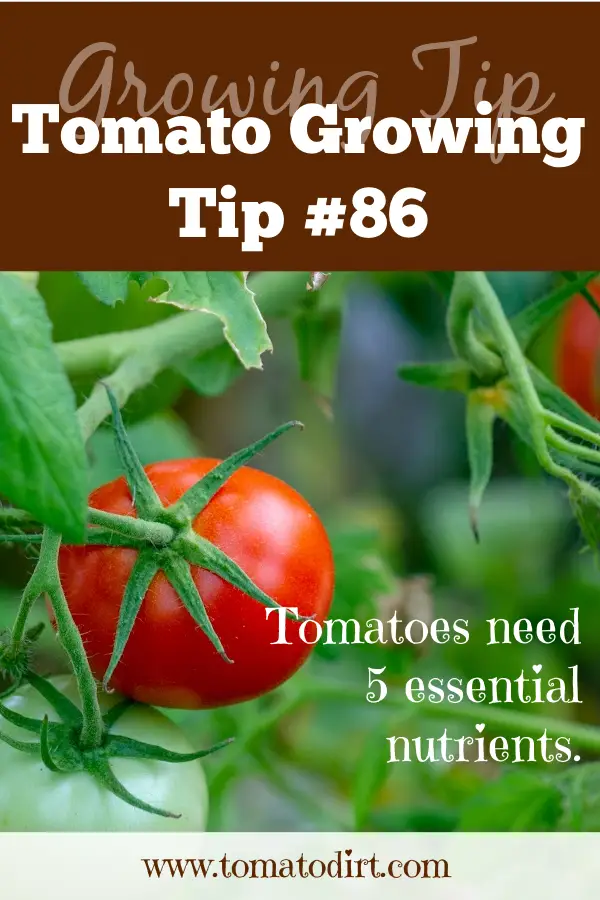FREE: 10 Must-Know Tomato Growing Tips Get The Guide
Read our affiliate disclosure here.
What Nutrients Do Tomatoes Need?
Since 2010, Tomato Dirt has garnered 4.8+ million views, making it the web’s leading online source for growing tomatoes in the home garden. Award-winning writer and Tomato Dirt owner Kathy Widenhouse has helped thousands of home gardeners grow healthier tomatoes. Be one of them when you get Tomato Dirt’s Growing Guide here.
Updated 6.10.25
What nutrients do tomatoes need in order to be healthy and produce a bumper crop? Tomato plants are big feeders. There’s a good chance your unamended garden soil doesn’t contain enough nourishment to sustain them through the long growing season.
Even if you have a rich garden bed, you want to make sure there’s enough of the right thing in your soil.
And while it’s great to cultivate your spring season garden with lots of organic material, that’s not the end of the story for tomatoes. From germination to fruiting, tomato plants have specific nutritional needs. You face challenges if your soil lacks one of the Big 5 nutrients that tomatoes need the most.
What nutrients do tomatoes need most?
Tomatoes require five essential nutrients. Here’s why each of these Big 5 is crucial for overall tomato health.
- Nitrogen (N): Nitrogen is fundamental for plant growth as it is a key component of chlorophyll, the pigment responsible for photosynthesis. It promotes lush foliage, strong stems, and vigorous growth. Without sufficient nitrogen, plants can become stunted. Their leaves yellow and yield goes down.
- Phosphorus (P): Phosphorus plays a vital role in helping energy to move around within plants. Plus, it aids in root development, flower formation, and fruit set. If you’re looking for overall plant vigor and ensuring healthy growth from seedling to maturity, then phosphorus is the nutrient to call upon. Insufficient phosphorus can lead to weak root systems, delayed flowering, and poor fruit development.
- Potassium (K): Potassium regulates water uptake, transports nutrients, and activates enzymes in plants. And there’s more. With enough potassium, your tomato plants are better able to resist disease. They’ve got better fruit quality and are able withstand environmental stressors such as drought or disease.
- Calcium (Ca): Calcium is essential for forming strong cell structures in your tomato plants, particularly in fruits. That’s why it’s a key ingredient in preventing blossom end rot. Adequate calcium uptake ensures strong, healthy plants with resilient tissues. https://www.tomatodirt.com/blossom-end-rot.html
- Magnesium (Mg): Magnesium is a component of chlorophyll and plays a crucial role in photosynthesis – clearly, it’s needed to help your tomato plant put out all those stems and leaves! Plus, magnesium helps plants produce sugars and then transfer all that energy within the plant which leads to robust growth and healthy foliage. Magnesium deficiency can lead to yellowing between leaf veins (interveinal chlorosis) and reduced photosynthetic efficiency. Plenty of gardeners use Epsom salts, which are an excellent source of magnesium, to enrich their soil for tomatoes.
How to help your tomato plants get the nutrients they need
Most fertilizers are a combination of the top three nutrients commonly fed to plants: nitrogen, phosphorus, and potassium (referred to as the “N-P-K ratio”). These nutrients work together to support various aspects of plant growth and development. Nitrogen promotes vegetative growth, phosphorus supports root and flower development, potassium regulates plant functions and enhances fruit quality.
Be aware that tomatoes need more potassium than any other nutrient. You can know the balance of nitrogen, phosphorus, and potassium when you look at the three-digit number on a fertilizer’s packaging. For example, a fertilizer with a 5-10-10 assignation will have 5 parts nitrogen, 10 parts phosphorus, and 10 parts potassium. That higher number of potassium will promote flowering, fruiting, and overall plant health for your tomato.
Tomato plants need calcium and magnesium, too. Calcium strengthens cell walls and prevents disorders, and magnesium ensures efficient photosynthesis and nutrient utilization. That’s why it’s a good idea to choose a balanced tomato fertilizer like Miracle Gro Tomatoes or Tomato Tone for your plants – a tomato fertilizer is specially formulated with the Big 5.
Beyond those basics, tomatoes have specific nutritional needs during each stage of development.
What nutrients do tomatoes need as new seedlings?
You definitely want to get your plants off to a strong start. And the easiest way is by ensuring that your tomatoes have the 3 main ingredients in most fertilizers.
- Nitrogen (N): Nitrogen is essential for promoting early growth and the development of strong stems and leaves. Without sufficient nitrogen, tomato seedlings get stunted and their leaves turn pale yellow.
- Phosphorus (P): Phosphorus is crucial during germination to establish a healthy root system. Insufficient phosphorus can lead to weak root growth and poor nutrient uptake. Not what you want when you’re helping your tomato plants to get a good start.
- Potassium (K): Potassium helps regulate water uptake and nutrient transport, ensuring that young tomato plants can withstand environmental stressors.
What nutrients do tomatoes need to grow strong stems and leaves?
Once your tomato plants move into their "adolescence," their nutritional needs shift slightly. They're getting ready to reproduce.
- Nitrogen (N): A consistent supply of nitrogen helps tomato plants sustain healthy leaf and stem growth. A lack of nitrogen at this stage can result in stunted growth and yellowing of older leaves.
- Calcium (Ca): Calcium contributes to cell wall strength. Adequate calcium uptake ensures sturdy stems and healthy leaf development to help plants get ready for blossoming.
- Magnesium (Mg): Magnesium is a component of chlorophyll and is crucial for photosynthesis. It aids in the production of sugars and energy transfer within the plant, promoting lush foliage growth.
What nutrients do tomatoes need to fruit?
Your tomato plants are now adults. They need certain nutrients in order to give you a healthy, luscious crop.
- Phosphorus (P): Phosphorus promotes strong, healthy blooms and after that, ensures that fruit sets and develops.
- Potassium (K): Once your tomatoes start setting fruit, potassium plays an important role. It regulates water balance and enhances fruit quality – which in turn prevents problems like tomato cracks.
- Calcium (Ca): Calcium is essential for preventing disorders like blossom end rot, which can affect fruit quality. It also supports cell division and contributes to overall fruit structure.
What nutrients do tomatoes need to ripen?
All those yummy red, pink, orange and yellow tomato skin colors don’t get there by chance. Specific nutrients allow tomatoes to ripen properly and develop their characteristic color, flavor, and texture.
- Potassium (K). Enzymes responsible convert starches into sugars, which helps tomatoes develop flavor as they ripen. Potassium helps the conversion process. And along the way, potassium helps fruit stay firm.
- Calcium (Ca). We know that early in a tomato’s fruiting process, calcium deficiency can lead to blossom end rot, affecting fruit quality and shelf life. And further, we know that calcium is a strengthening agent in human bones. But now, just as a tomato is getting ready to cross the finish line, calcium plays a big role. It helps strengthen cell walls in ripening tomatoes and prevent physical damage during the harvesting process.
- Ethylene. True, it’s not a nutrient. Nevertheless, ethylene – a plant hormone – plays a pivotal role in the ripening process. It triggers the production of enzymes such as ethylene synthase and polygalacturonase (say those three times fast!), which promote fruit softening and color development. Ethylene gas is naturally produced by tomatoes as they ripen. And external sources of ethylene, such as ripe fruits or ethylene-releasing agents, can also accelerate ripening.
- Carotenoids. These pigments are responsible for the red, orange, and yellow colors in ripe tomatoes. Lycopene and beta-carotene, in particular, contribute to the vibrant coloration and antioxidant properties of ripe tomatoes. Give your tomato plants adequate sunlight exposure and a good balance of nitrogen and phosphorus, and you can influence healthy carotenoid production – which leads to vivid fruit colors on your fruit.
- Sugar content. Sugars are not soil nutrients per se. However, glucose and fructose are crucial for flavor in ripening tomatoes. Balanced fertilization and soil amendments enhances sugar accumulation in your plant and improves fruit taste.
What micro nutrients do tomatoes need?
It’s true that just a handful of major nutrients impact your tomato plant health and production. But there are several “little fish” that help your plant towards optimal health and production. These micronutrients, also known as trace elements or trace minerals, are essential nutrients that tomatoes need in smaller quantities compared to the Big 5 macronutrients (nitrogen, phosphorus, potassium, calcium, and magnesium).
- Iron (Fe): essential for making chlorophyll.
- Manganese (Mn): helps in activating enzymes and plays a role in photosynthesis.
- Zinc (Zn): helps regulate hormones regulation synthesize proteins.
- Copper (Cu): supports enzyme function and nutrient uptake.
- Boron (B): enables blossoms to form. In addition, boron plays a key role in germination and fruit set.
Common mistakes in getting tomatoes the nutrients they need
- Overfertilizing. Be careful not to be too heavy-handed with nitrogen, especially later in the season. Too much can lead to lush foliage but inhibit flowering and fruiting. Follow recommended application rates to avoid the imbalance.
- Neglecting micronutrients. By all means, be sure your tomato plants get the all-important NPK trifecta (nitrogen, phosphorus, potassium) and the accompanying duo (calcium and magnesium). But don’t overlook micronutrients. Doing so can result in nutrient deficiencies and reduced plant health. Use a balanced tomato fertilizer to counteract this omission.
- Poor timing. If you apply fertilizer too early in the growing season, you can burn out seedlings or disrupt nutrient uptake. Too late and your plants won’t develop in the healthiest way. Best recommendation: add a handful of tomato fertilizer or bone meal to when planting. Keep a careful eye on newly planted seedlings for the first two weeks. Transplanted seedlings with yellowed leaves at the base need to be fed again. Apply tomato fertilizer once fruit has formed. Then, apply tomato fertilizer every 3 weeks until frost.
Tomato plants are a lot like humans in this: give them the nutrients that they need – and when they need them – and you can help them grow healthy and strong.
More about fertilizing tomatoes
What’s the Best Tomato Fertilizing Schedule?
How to use tomato fertilizer to get the best tomato production...
Kinds of tomato fertilizer ...
Organic tomato fertilizer: advantages and disadvantages...
Epsom salts: a natural tomato fertilizer ...
Does tomato fertilizer potency stay strong over time?
Tomato fertilizer question: will this fertilizer work for tomatoes?
See more on our Fertilizing Tomatoes Pinterest board...
Return from What Nutrients Do Tomatoes Need? to Tomato Dirt home
As an Amazon Associate and Rakuten Advertising affiliate I earn from qualifying purchases.
SHARE THIS PAGE:
FREE! 10 Must-Know Tomato Growing Tips: 20-page guide
Get yours here:









